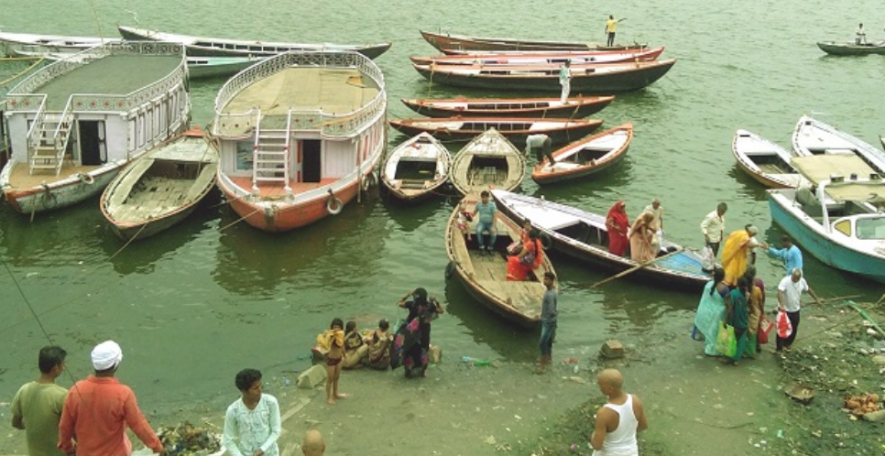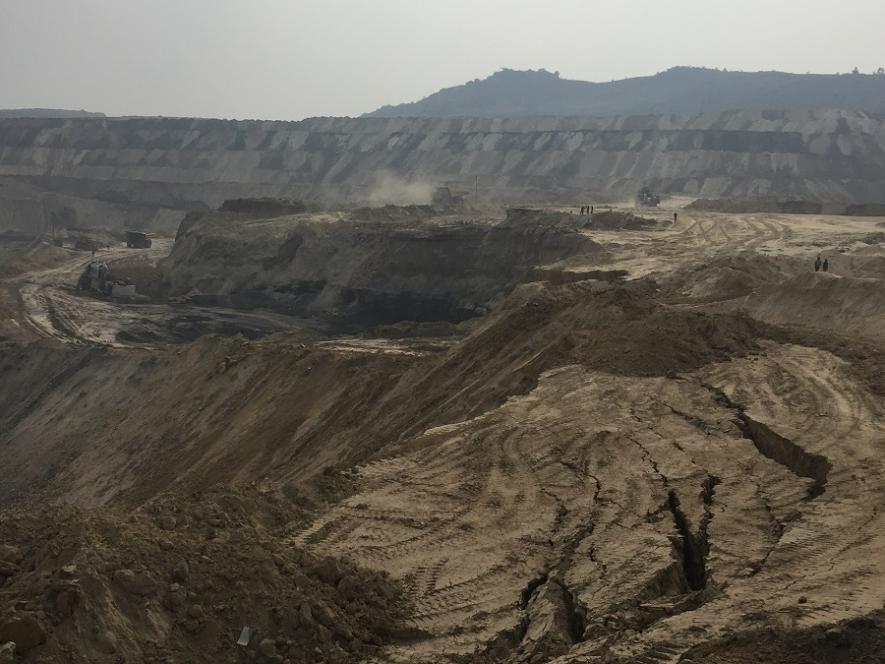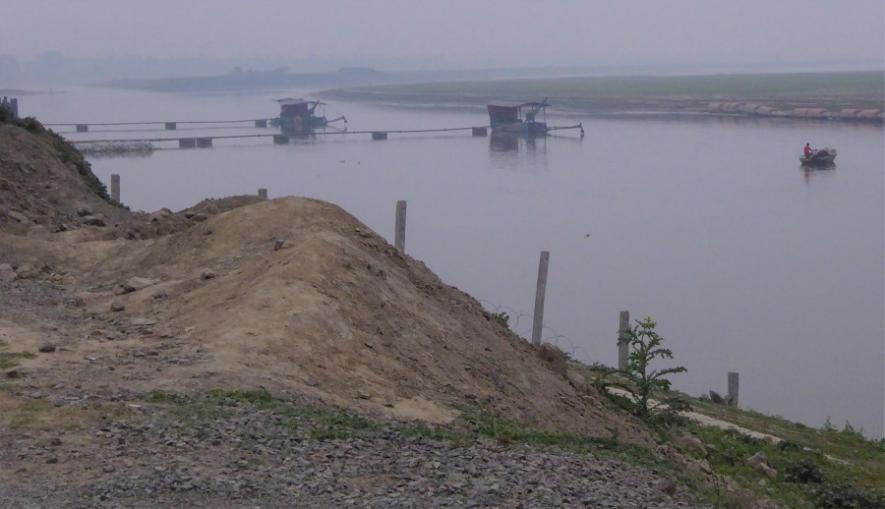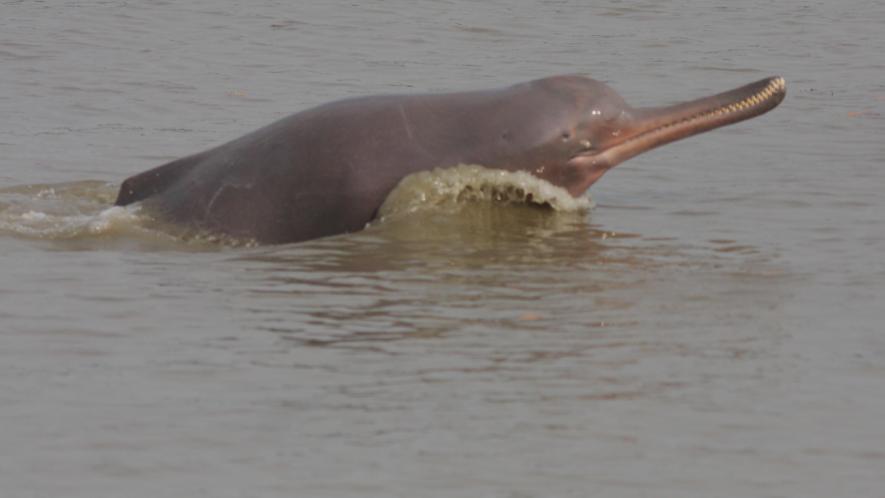Adani’s Power Plans Threaten PM Modi’s Promise to Restore the Ganges River

‘I feel Mother Ganges has called me to Varanasi,’ said Narendra Modi in 2014 as he launched his campaign to become Prime Minister of India. The holiness of the Ganges River to Hindus was a constant theme in Modi’s successful pitch to the Indian electorate. But he didn’t just speak about the river’s religious significance; he also spoke passionately about the river’s practical significance as a source of water to millions and as a remarkable natural feature facing enormous threats.
On taking office, Modi promised to restore the great river’s cleanliness and flow. In 2015, he pledged over US$3 billion to clean up the Ganges, a river damaged and degraded by dams, diversions, industrial pollution, raw sewage and plastic litter. He established the Ministry of Water Resources, River Development and Ganga Rejuvenation. A moribund river authority was replaced by a new institution – the National Ganga Council. An ambitious program of research, monitoring and projects was laid out. People had reason to feel optimistic about the future of the Ganges and its threatened life forms.
Five years later, there is deep disappointment. In October 2018, a prominent advocate for the Ganges died after 111 days of fasting to protest the lack of action to address the river’s many problems. For almost all of its length, the river’s waters are unfit even for bathing. According to international news outlets such as Reuters, many of the promised funds for clean-up programs have not materialised. Less than one third of the promised clean-up projects have commenced. And the Modi Government, under the guise of minimising delays to new industrial projects, has dismantled environmental protections and put in place a speedy process for granting approvals. Numerous waterway developments have been given the green light, despite warnings from experts about resulting impacts on the health of the river. And one of the players contributing to the trashing of Modi’s pledge to save the Ganges River is the Adani Group.
Adani plans to draw millions of cubic metres from the lower Ganges every year. The water will be piped to the company’s massive power plant (currently under construction) at Godda where it will be used to wash coal, to manage industrial wastes, and to generate steam to power the turbines. In 2019, Adani’s plans to deplete India’s holiest of rivers received environmental clearance – despite potential impacts on threatened species, such as the Gangetic dolphin, that depend on the river.
Such concerns echo criticisms of Adani’s water management in Australia, where it is feared that the company’s Carmichael mine (which is planned to supply the coal to the Godda power plant) will have serious impacts on the Doongmabulla Springs and the Great Artesian Basin.

Prime Minister Modi notoriously used Gautam Adani's private plane while on the campaign trail in 2014.
Adani’s apparent disregard for Prime Minister Modi’s pledge to restore flow to the Ganges is ironic. The close relationship between the Adani Group’s founder, Gautam Adani, and the prime minister is well known. They forged close bonds during Modi’s time as Chief Minister of Adani’s home state of Gujarat, while Adani was building his corporate empire. When Modi was running for Prime Minister in 2014, he notoriously used Adani’s personal aircraft while on the campaign trail.

A non-Adani coal mine between Godda and the Ganges. Photo by Geoff Law
In February 2020, AdaniWatch visited the Ganges River. Freelance journalist Abir Dasgupta and I had just completed a tour of villages directly affected by Adani’s massive construction site at Godda. This is the power station which (if it is completed) will burn the coal from Adani’s Carmichael mine (if it is completed). Given the importance of the waters of the Ganges River to Adani’s plans, it made sense to also visit the proposed water intake just downstream of the town of Sahibganj.
Our window of opportunity was small – less than a day. I was excited. The mystique of the river was alluring. However, other obligations delayed us and it was after midday when we finally left Godda, with a drive of at least three hours before us. At first, the scenery was pleasant. Rice fields, woodlands and pastures were punctuated by the occasional boulder-strewn outcrop. Busy little villages were frequent. It was a mild, sunny winter’s day.
Suddenly a void opened before us. The agricultural landscape had been devoured. We peered over a man-made precipice into a hellish scene of haulage roads, huge machines, bare rock and clouds of dust. Distant human figures were dwarfed by this pit which stretched as far as we could see. It was a coal mine – not one of Adani’s, but still a graphic reminder of the incongruity of the company’s intentions to transport coal from Australia by truck, ship and rail over 10,000 kilometres to a place where there are already dozens of coal mines just as big as this one.
We followed the edge of the mine for nearly an hour. Its effects were not limited to the physical devastation. Adjacent villages were enveloped in a cloud of fumes from coal-fed cooking fires. A dull grimy greyness coated everything. Fugitive quantities of coal made their way from the mine to the villages by all manner of transport. Our car slowed on the narrow road as we approached a man laboriously pushing a bicycle – a dozen slabs of coal the size of watermelons were tied to its frame and handlebars. The load must have weighed more than 100 kilograms.
Eventually, we reached Sahibganj whose congested, noisy roads we had to navigate while finding our way to a meeting place with a local who had kindly agreed to show us around. By the time we had been guided to a hillock overlooking the Ganges it was nearing sunset.
A pungent gloom filled the valley. The still conditions of winter had trapped the smoke from nearby industry and thousands of coal-fed fires. Industrial infrastructure lined the near bank of the Ganges. The opposite bank was not visible, the dull waters of the great river merging imperceptibly into the hazy sky. The soundless river’s surface betrayed no movement – it was as if the water was not flowing at all.
Depletion of the Ganges’ waters is one of the threats to its health. The river’s basin occupies over a quarter of India’s land area and supports 47% of its population, so the demands on its waters are immense. A government authority recently published a report on the river entitled ‘Vision Ganga’. It identifies ‘industrialisation’, ‘over-use of natural resources’ and ‘piecemeal engineering operations’ as significant contributors to the river’s continuing degradation. The document said that a new objective of management of the Ganges was to maintain environmental flows. Prime Minister Modi expressed this in the language of the populace when he promised to restore the ‘avralta’ – the free flow – of Mother Ganges.
Yet here, at Sahibganj, Adani plans to deplete the sluggish river’s waters still further. The company’s bid for environmental clearance in 2018 said that it would remove 36 million cubic metres per annum from the Ganges. We drive past a new port and a jetty to the proposed intake area. There’s not much to see, especially in the dying light. A security gate and a guard block access to the construction area. There are a couple of old irrigation pumps in the river; in the background is a low-lying sandy island; behind us trucks queuing up for a ferry are blaring music. We loiter while Abir talks to an elderly passerby. He tells me later that the gentleman had described the forthcoming impacts of Adani’s proposed pumping station, reservoir and pipeline on local landowners.
‘The pipeline will pass through people’s land but these lands have been shown as government-owned land,’ the man, who did not wish to be identified, told Abir. ‘This has been done to avoid paying compensation. This has happened to people of eight or nine villages. Only about 40 families have been able to receive compensation.’
The Gangetic dolphin is not the only threatened species here. The thirty-four kilometres of river downstream of Sahibganj have been identified as a ‘high-biodiversity stretch of river’. The river is very wide and highly braided, forming multiple channels on an alluvial plain. Its flow is enhanced by a substantial tributary. The resulting features include deep pools, sandbars and mid-river islands, all of which form habitat for freshwater turtles, island-nesting birds and dolphins. A species of otter, 89 species of fish, 182 phytoplankton species, and 40 zooplankton species have recently been recorded here, as well as the seven dolphins. This is the very stretch of river where Adani is building its pumping station. Experts say that the potential impacts of Adani’s development should be properly evaluated. Nachiket Kelkar, a Member of the IUCN Cetacean Specialist Group, for example, says ‘the effects of water diversion at Sahibganj, depending on the magnitude and seasonal diversion pressure, are likely to affect habitat for river dolphins directly, especially during the dry season from March to June. This is an important issue and needs to be assessed as a major environmental impact of the project’. ‘The river dolphin is already endangered by many threats’, he goes on to say, ‘which include reduced dry-season flows caused by water diversions from dams and barrages, bycatch mortality in fishing nets, poaching, and river pollution. Lately, increases in vessel traffic, river bottom-dredging and port construction (including at Sahibganj) are also likely to affect river dolphins. The cumulative impacts of all these threats, in relation to the proposed water diversion, need to be scientifically assessed’. Government statements also call for rigorous evaluation of planned infrastructure. ‘This mighty river system and its aquatic wildlife are under severe threat due to the unsustainable use of its resources, reduced flow, water pollution and conversion of riparian areas and river islands,’ says the Minister for Water’.

The Ganges River at the intake for Adani's pipeline. Photo by Geoff Law
Later, we drive past a geometrical array of box-like dwellings that we were told are being constructed to house the people that will be displaced by Adani’s infrastructure.
Potential impacts of Adani’s water diversion go well beyond the immediate environs. This meandering stretch of river has been identified as important habitat for the Gangetic dolphin, with seven encountered here during a recent survey. The dolphin, which can grow to two and a half metres long, is the national aquatic mammal of India. It is restricted to the major lowland rivers of Bangladesh, Nepal and northern India, particularly the Ganges. According to the species’ entry in IUCN’s ‘red list’, its populations have become ‘severely fragmented’ with a total number somewhere between 2000 and 4000. These remaining dolphins are threatened by pollution, hunting, increasing boat traffic, water diversion, and entanglement in fishing nets. The animal is effectively blind, eyesight being of little use in the perennially murky waters of the Ganges. It navigates and forages using echolocation, emitting squeaks, twitters and clicks that bounce off nearby surfaces. The dolphins therefore find noise from river vessels and pumping stations disorienting.
Adani’s water-pumping infrastructure at Sahibganj could therefore impact the Gangetic dolphin in two ways – through reducing the river’s flow, and through the noise of another major pump. On the subject of reduced flow, IUCN says ‘although the long-term implications of reduced dry-season flows in the Ganges are catastrophic, both for the survival of river dolphins and a major portion of the world’s human population that inhabits the Ganges basin, the cumulative effects of reduced water supplies have received little attention’.

Gangetic dolphin - a species threatened by further degradation of the Ganges River. Google Images
The Gangetic dolphin is not the only threatened species here. The thirty-four kilometres of river downstream of Sahibganj have been identified as a ‘high-biodiversity stretch of river’. The river is very wide and highly braided, forming multiple channels on an alluvial plain. Its flow is enhanced by a substantial tributary. The resulting features include deep pools, sandbars and mid-river islands, all of which form habitat for freshwater turtles, island-nesting birds and dolphins. A species of otter, 89 species of fish, 182 phytoplankton species, and 40 zooplankton species have recently been recorded here, as well as the seven dolphins.
This is the very stretch of river where Adani is building its pumping station.
Experts say that the potential impacts of Adani’s development should be properly evaluated. Nachiket Kelkar, a Member of the IUCN Cetacean Specialist Group, for example, says ‘the effects of water diversion at Sahibganj, depending on the magnitude and seasonal diversion pressure, are likely to affect habitat for river dolphins directly, especially during the dry season from March to June. This is an important issue and needs to be assessed as a major environmental impact of the project’.
‘The river dolphin is already endangered by many threats’, he goes on to say, ‘which include reduced dry-season flows caused by water diversions from dams and barrages, bycatch mortality in fishing nets, poaching, and river pollution. Lately, increases in vessel traffic, river bottom-dredging and port construction (including at Sahibganj) are also likely to affect river dolphins. The cumulative impacts of all these threats, in relation to the proposed water diversion, need to be scientifically assessed’.
Government statements also call for rigorous evaluation of planned infrastructure.
‘This mighty river system and its aquatic wildlife are under severe threat due to the unsustainable use of its resources, reduced flow, water pollution and conversion of riparian areas and river islands,’ says the Minister for Water Resources, River Development and Ganga Rejuvenation, Nitin Gadkari, in a foreword to the government’s 2017 report on the river’s aquatic fauna. ‘The rising human population and resulting urbanisation and economic growth will further intensify these threats. Therefore, rejuvenation of the river ecosystem is critical to restore its ecological integrity and to ensure the survival of its aquatic species such as the iconic Gangetic river dolphin’.
Similar sentiments were expressed by the Director-General of the National Mission for Clean Ganga. ‘Vision Ganga’, produced under the auspices of his organisation, proposes remedies for the stricken river that include maintaining environmental flows, regulating diversions of water, and ensuring transparent scrutiny of planned developments.
All of these pointed to the clear need for a comprehensive assessment of the impacts of Adani’s proposed removal of water from the Ganges. And yet, on 3 September 2019, the Ministry of Environment, Forest and Climate Change issued an approval for the Godda power station, including the use of Ganges River water. As part of the process that led to this decision, the National Mission for Clean Ganga, the body charged with restoring the river to good health, furnished Adani with a ‘notice of consent’, giving Adani its blessing.
There had been no open or comprehensive scientific assessment of Adani’s plans, let alone any public participation in the process. The potential impacts on the Ganges River dolphin, other threatened aquatic wildlife, and the health of the river appeared to have been ignored. It was as if Prime Minister Modi had never spoken of his calling to restore Mother Ganges to cleanliness and free flow.
Abir and I left Sahibganj by overnight train, the acrid stench of coal fumes penetrating the carriage at every whistle stop during the long night. Soon, we would leave the state of Jharkhand altogether. But local inhabitants affected by Adani’s plans did not have the opportunity to leave. At Godda, rather than watch the permanent destruction of their livelihoods and traditions, a small band of them was challenging Adani’s acquisition of their lands in the courts. And a similar act of defiance was underway in a national forum, with the Ganges River at centre stage.
In Delhi, I met Sreedhar Ramamurthi, co-founder of the Environics Trust, a not-for-profit organisation that helps communities develop sustainably. Sreedhar himself trained as a geologist and worked for the department of atomic energy and then the oil industry until, in the 1980s, he decided to work with communities. He helped set up renewable-energy projects and then realised, in the 1990s, that there was even more important work to do in protecting the land from the wave of mining projects sweeping the country in the wake of economic liberalisation. In the last five or six years, he has focussed on coal.
In November 2019, Sreedhar filed a case with the National Green Tribunal, India’s equivalent of an EPA, to have the environmental approval of the Godda power station quashed. This was after his earlier petition, which challenged the entire conception of the project, was disposed of by the Tribunal without any substantial orders. In his affidavit, Sreedhar describes himself as ‘a public spirited and socially motivated and environmentally vigilant citizen of the country’. Foremost amongst his arguments is the government’s failure to adequately assess the impacts on the Ganges River.
A critical point is that Adani’s original plan was to draw water from a different river, the Chir. When this was approved in August 2017, Sreedhar appealed the decision, presenting evidence that the Chir had insufficient water both to meet Adani’s demands and to retain its environmental integrity. Meanwhile Adani was putting in place a plan to substitute the Ganges for the Chir. It requested and received a ‘notice of consent’ from the National Mission for Clean Ganga, with the amended environmental approval following in due course. Sreedhar argues that, under the law, there should have been a new assessment, given the significance of the modification.
‘We are saying that the environmental clearance must be cancelled and a comprehensive environmental assessment of the pipeline, the railway line and the thermal power plant must be done,’ Sreedhar says. ‘Instead they approved the power plant and then the pipeline is added on later, and the railway line is added on later again.’
When it comes to the project’s impact on the Ganges River, Sreedhar says the government’s panel acted in ‘an extremely casual manner’ that was both ‘unscientific’ and ‘lackadaisical’. He says that Adani’s water-sustainability report was not prepared by experts on river dynamics and ecology. As evidence of its failings, he points to a section which suggests that any ‘habitat shrinkage and alteration’ caused by the loss of water could be rectified by dredging, and that this would result in habitat for the Gangetic dolphin and other fauna being ‘enhanced’. Other issues not adequately examined by the government include the placement of dredge spoil, the potential impacts of periodic flooding on Adani’s pumping infrastructure, the likely concentration of toxic substances such as mercury and selenium in Adani’s storage reservoirs, and impacts on the Gangetic dolphin arising from the noise of the water pumps.
Adani, meanwhile, says that its Godda operation will be one of the most sophisticated and technologically advanced coal-fired power plants in the world.
‘Adani has all of the requisite approvals in place for environmental management, including water usage,’ said an Adani spokesperson, ‘and is investing the equivalent of approximately $USD300 million on environmental monitoring-systems and protection equipment to ensure compliance with regulatory and sustainability requirements. Water from the Ganges River will be brought from Sahibganj to Godda through a water-pipeline, for which all approvals from the Jharkhand State Government have been obtained.’
The spokesperson said that Adani had set up 120 schools in the Godda district to fulfil the government’s educational programs, and had provided health checks, treatment and economic support for thousands of people across the region during the covid-19 pandemic.
Meanwhile, the National Green Tribunal has sat on Sreedhar’s case for over four months. It is not known if or when it will carry out any hearings. In the meantime, parts of the government have made life difficult for Sreedhar and the Environics Trust.
‘They have tried all their tricks’, he says. ‘But this is probably the most disastrous project from the perspective of climate change and corporate behaviour. The local people and many of us – we are not going to leave this case easily’.
The fight against the Godda power station and its impacts on the Ganges continues, with government forces backing Adani at every turn.
Ironically, it was the Indian government in 2013 that made a huge step forward in the recognition of the rights of dolphins, declaring them to be ‘non-human persons’. It banned the capture of cetacean species for entertainment, halting the development of dolphin shows in India. Environmentalists hoped, at the time, that the move would have positive ramifications for the Ganges River dolphin as well. But the decision to approve Adani’s extraction of water from the Ganges has dashed those hopes and made a mockery of Prime Minister Modi’s promise to restore the flow to the holiest of India’s rivers.
Get the latest reports & analysis with people's perspective on Protests, movements & deep analytical videos, discussions of the current affairs in your Telegram app. Subscribe to NewsClick's Telegram channel & get Real-Time updates on stories, as they get published on our website.
























